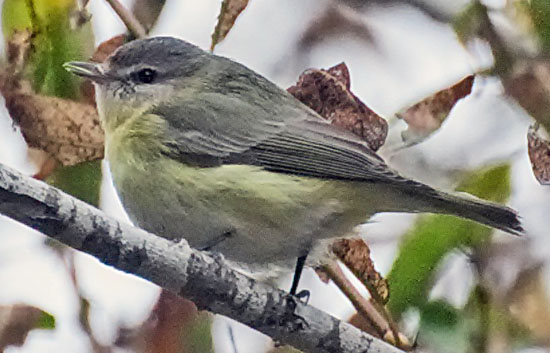|
||||
These highlights chronicle the year 2017. Created
incrementally as new photos were available, the year runs generally
"backwards" on this page. The abbreviation "MTY" means "Monterey County" in the text below. Text by Don Roberson. Photos on this page are copyrighted by the photographers to whom they are attributed, and may not be reproduced in any form (including other web sites) without the express consent of the photographer. |
||||
 |
||||
We hope it might winter, as the species has done once before in southern California. It was remarkably elusive on some days but was seen through 31 Dec. There is just one prior record for MTY: one netted and banded farther downstream along the Big Sur River, within Andrew Molera SP, by the then-existing Big Sur Ornithology Lab on 30 May 2003. |
||||
Single Lucy's Warblers in Pacific Grove on 7 Dec (Blake Matheson) and at Carmel R. mouth on 30 Dec (Brian L. Sullivan) were excellent December vagrants. |
||||
Meanwhile, on 22 Dec, Paul Fenwick found and photographed a dark-morph "Harlan's" Red-tailed Hawk in the lower Carmel Valley (photo right © Paul Fenwick). A "Harlan's" was seen again at Carmel R. mouth near year's end (B.L. Sullivan). This is only the 3rd MTY record; the most recent was at Elkhorn Slough Reserve in Feb 2016 (see that seasonal report). The formal MAS Pt. Pinos seawatch [see below] concluded on 15 Dec, with Karl Bardon recording 142 species over his 6 weeks of seawatching, but the generally calm conditions turned to strong NW winds the very next day. Karl set up his tripod one last time on 16 Dec and was among those to record a dozen Fork-tailed and a single Leach's Storm-Petrel that date. Another Fork-tailed was seen on the Monterey Peninsula CBC from Pt. Pinos (Rob Fowler). |
||||
Up to 2 juv Pacific Golden-Plover, discovered by Amanda Preece on 14 Dec on the rocky shores of Asilomar SP, may be attempting to winter (photo left on one of them on14 Dec © Blake Matheson). A handful of Pacific Golden-Plovers have wintered locally in past years. In late November, a recently plowed field along Molera Rd., just southeast of Moss Landing, attracted up to 10 Pacific Golden-Plovers, plus up to two each of Lapland and Chesnut-collared Longspurs. A visitor to Pt. Lobos State Reserve on 5 Dec photographed this Scissor-tailed Flycatcher there with her iPhone (below right © Brook Knowles). This appears to be the 13th MTY record. Alas, efforts to relocate it in subsequent days were unsuccessful. |
||||
|
||||
Several interesting birds that arrived earlier in the fall lingered to year's end in addition to the Yellow-breasted Chat (discussed below). Among them were an incursion of Red Crossbills, first noted in Pacific Grove on 6 Sep. Small flocks have scattered across the Monterey Peninsula and Jacks Peak; Blake Matheson's excellent photo of a male was taken near Jacks Peak (above left, taken 24 Nov © B.T. Matheson). Only two "types" of Red Crossbills have been known to reach Monterey County. Various incursions have been attributed to "type 2 or Ponderosa Pine Crossbills," particularly huge numbers in fall 1996 [tape-recordings by locals confirmed by Jeff Groth]. More recently, in fall 2012 and again in winter 2014-2015, recordings have confirmed the presence of "type 3 or Western Hemlock Crossbills." Various observers describe calls in varying ways; I (D. Roberson) tend to describe the calls of type 3 as "softer, light scratchy 'jip-jip-jip' calls" compared to the "loud, sharp, staccato 'kip-kip-kip' notes" of type 2 crossbills. However one says it, the experienced locals feel that this fall's flight is of type 3 Western Hemlock crossbills, and presumably Blake's photo is of one of them. A male Summer Tanager, first noted 20 Nov in Pacific Grove (D. Roberson) was back in town for its 5th winter of occurrence, and making its usual rounds from the vicinity of the P.G. ballpark south to near Asilomar Conference grounds. Another Summer Tanager, this one a first-year immature, was found at Asilomar on 27 Dec (Amanda Preece). |
||||
November Seaside's Laguna Grande Park once again became the center of the MTY birding scene in November. It began Friday, 3 Nov, when Mark Kudrav discovered a Scarlet Tanager in the "chat patch" portion of the Virgin patch [photo near right 4 Nov © Cooper Scollan]. The tanager would linger to 12 Nov and be seem by perhaps a hundred observers from far and near. The "chat patch" was named for a Yellow-breasted Chat — present from 20 Nov 2016 to 21 Apr 2017 — that was the first to winter in northern California. Remarkably, a visitor looking for the tanager found a Yellow-breasted Chat on 3 Nov, back in the "chat patch"! Since this chat was in fall adult plumage [e.g., black lores, photo far right from 11 Nov © Steve Rovell], we believe it is the same chat returned for its second winter [it was still present through 27 Dec]. |
||||
Yet
both these birds, as exciting as they were, were overshadowed by a
pewee. Mark Kudrav found a pewee on 3 Nov — a date that would be quite
late for any Western Wood-Pewee — but photos were backlit and without
vocalizations, it was generally presumed to be a very late Western. Don
Roberson and Rita Carratello relocated it on 5 Nov and obtained better
photos [e.g., below left 5 Nov © Don Roberson, below right 7 Nov
© Rita Carratello]. Roberson suggested that its pale plumage,
including white undertail coverts and the bill pattern, better fit Eastern Wood-Pewee,
and encouraged others to take a second look. Many did, including Brian
Sullivan who was able to obtain diagnostic vocalizations of Eastern
Wood-Pewee by using playback techniques [you can listen to sets of
calls on Brian's eBird list of 5 Nov]. The pewee remained to 10 Nov, giving many birders across California a chance to chase successfully.
|
||||
|
||||
|
||||
| At the tip of the Monterey Peninsula, the third annual Pt. Pinos Seawatch,
sponsored by Monterey Audubon Society, began its set of late autumn
daily dawn-to-dusk seawatches from Pt. Pinos on 1 Nov. As in 2015 and 2016,
Audubon engaged an experienced seawatcher from eastern North America to
conduct the surveys that run 1 Nov-15 Dec. This year's seawatcher is Karl Bardon
(below left & center), from Duluth MN, with extensive experience on
Lake Superior and at Cape May NJ. Although Karl's scope is bedecked
with 'clickers' to tally the hundreds of thousands of loons expected to
pass Pt. Pinos each fall (see the set-up in the middle shot below),
November's weather was extraordinarily warm with little winds (flat
calm seas in both photos, taken 13 and 18 Nov). His first three weeks
have shown that we are still missing 100,000 Pacific Loons that have
not yet arrived and are still presumably somewhere to the north.
Perhaps they will flood past in December? These seawatches are providing much new information on the year-to-year variation in the timing of migrations. It has also shown, as have past efforts, that tiny numbers of Black Scoter, Long-tailed Duck, and other waterfowl fly past the Point in flocks of Surf Scoters. In the photo, a male Black Scoter (surrounded by 4 Surf Scoters) is the only Black Scoter among the 1084 Surf Scoters that passed the Point in the 4-5 p.m. hour on 18 Nov (photo below right © Karl Bardon). The Seawatch's best birds in November were a Guadalupe Murrelet flying west (2 Nov), a Burrowing Owl that came ashore and headed east (2 Nov), a Lapland Longspur overhead (18 Nov), several Royal Terns, and the best of all: an adult Black-headed Gull flying past (27 Nov), watched with scopes by Brian Sullivan, Paul Fenwick, and Karl Bardon (but photo efforts too distant to publish here; nice written details though). The Black-headed Gull was a first MTY record! |
||||
|
||||
|
||||
| October This month is always a promising month for migrants. The smattering of vagrants was nice, especially the concentration at the South Bank trail (see a bit farther below). The month opened with single Red-throated Pipits on 6 and 14 Oct (Brian Sullivan), and an approachable Lapland Longspur [photo below left © Don Roberson, present 8-14 Oct], plus two Sage Thrashers, all at a restricted-access set of mostly-dry wastewater ponds near Salinas. The month concluded with a fine juvenal-plumaged Sharp-tailed Sandpiper at Moonglow Dairy, Moss Landing, found by Paul Fenwick [photo below right © P. Fenwick]. | ||||
|
||||
|
||||
The occurrences might suggest the flocks migrating south from Alaska became lost over the sea (due to fog?) and had to return northward to reach the intended winter locales. The numbers also illustrate the extent of the population's impressive comeback from "endangered" status just a half-century ago. |
||||
 |
||||
September
The two best birds for September 2017 occurred early in the month. The
first enjoyed the backyard birdbath of Maryann and Richard Wilson in
Pebble Beach on 7-8 Sep (below, photo by a neighbor, fide R.F. Tintle). It was a gorgeous Kentucky Warbler
— just the 6th for MTY. This is only the second one to occur in fall
migration. The other also frequented a backyard bird-bath — at the home
of Alan & Sheila Baldridge in Oct 1990. |
||||
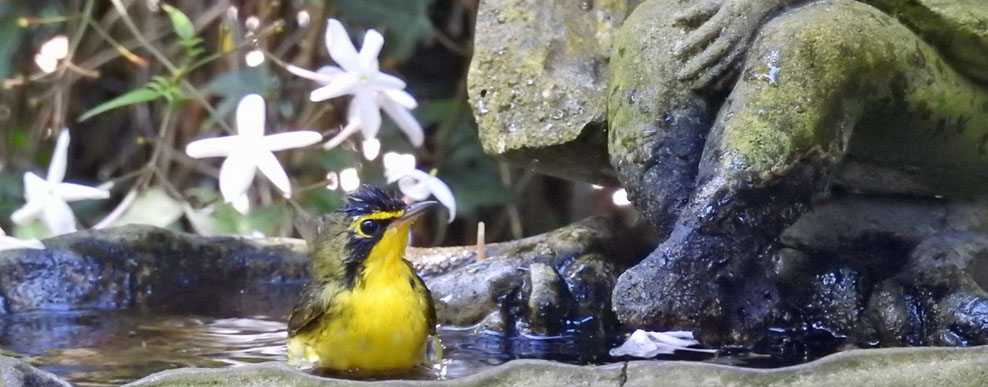 |
||||
The other major rarity in September was on the tidal mudflat at Jetty Road, Moss Landing, when discovered by Blake Matheson on 16 Sep: a Little Stint (below © B.T. Matheson). It was in fresh basic plumage. [It was photographed again on 19 Sep by Ryan Sanderson]. It represents the 4th MTY record, unless it is this spring's bird from the same spot returning, as some suggest. That bird was in breeding plumage [photo here, near top of page]. The first two Little Stints in MTY were in juvenal plumage at Moonglow Dairy: 14–22 Sep 1985 [details here] and 14 Sep 2008 [details here]. A Little Stint in basic plumage suggests that it could winter in the vicinity. Two prior Little Stints may have been attempting to winter in California. |
||||
 |
||||
 |
||||
Later the same day, Brian Sullivan found a hatch-year Magnolia Warbler in "the thicket" (right © B.L. Sullivan). Both the Ovenbird and the Magnolia were present through 4 Sep. We are now averaging about 2-4 Magnolias each fall (Roberson 2002). |
||||
Back in the summer a Sandhill Crane summered in the Moro Cojo / Moonglow Dairy vicinity, but was gone after 2 Sep. On 26 Sep a crane flew over Moonglow Dairy (P. Fenwick). Assuming the same bird was involved, where had it been in the interim? Most unexpectedly, an adult Sandhill Crane appeared at the Odello Lagoon adjacent to the Carmel River mouth for just a few hours on 24 Sep, where it was beautifully photographed (below © Paul Fenwick). This appears to be the first record for the entire Monterey Peninsula! |
||||
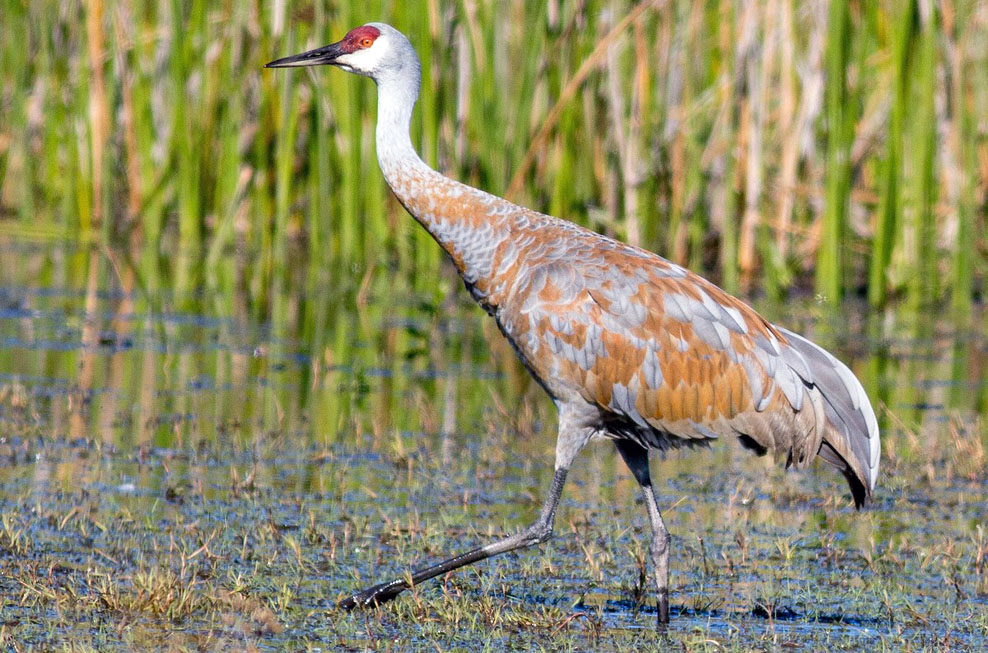 |
||||
|
||||
|
||||
Finally, as to Monterey Bay offshore, it was a pretty nice September in some respects — good numbers of Buller's Shearwater, a smattering of Scripps's Murrelet, a Brown Booby on 11 Sep (Mark Kudrav +) — but no major rarities were recorded within MTY waters. One improvement is that maps and new details about county borders offshore in Monterey Bay is now available. Late in September, Ryan Sanderson took this remarkable photo (below © Ryan Sanderson). It shows a Short-tailed Shearwater — upper left in the photo — in good comparison and focus with a Sooty Shearwater. Note subtle differences in shape between the two dark shearwaters, and even the shorter tail of the Short-tailed Shearwater (feet extend farther out). Two critical i.d. characters show very well. First, Sooty Shearwater has a prominent "silver flash" on the underwings concentrated in the greater underwing coverts and bases of the remiges. Short-tailed Shearwater has darker underwings and when pale areas are present, they are patchy and diffuse rather than concentrated. Second is the feature I use the most in the field: look at the bill. Sooty Shearwater has a larger and more 'ordinary' bill while that of Short-tailed is decidedly shorter and thinner. In early fall (Sep-Oct) when there are still masses of Sooty Shearwaters on Monterey Bay, it can be very hard to review claims of Short-tailed Shearwater. Many claims are undocumented and most likely wrong, as the larger numbers come later in the autumn. It is really nice to have such a photo to confirm the first Short-tailed Shearwater of the season. |
||||
 |
||||
Literature cited:
|
||||
| More highlights will be posted as they arise and
are
documented with
photos.
TO HIGHLIGHTS from JANUARY-APRIL 2018 TO HIGHLIGHTS from MAY-AUGUST 2017 Page created 10 Oct 2017, last updated 31 Dec 2017 |
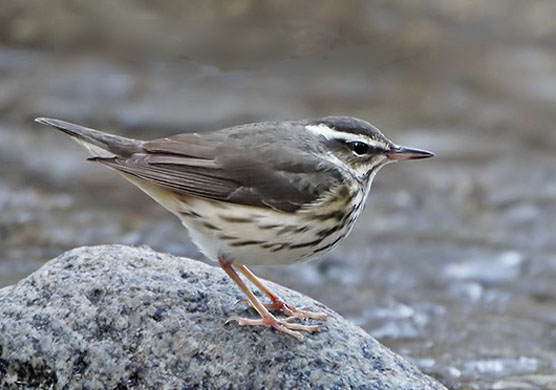 December
The year typically winds down with our local Christmas Bird Counts —
Big Sur CBC on 17 Dec and Monterey Peninsula CBC on 27 Dec this year —
but it was a major rarity found by a visiting birder that was the
Christmas present for many local observers. David Dolavina was birding
along the Big Sur River in Pfeiffer Big Sur SP on 23 Dec when he
discovered this Louisiana Waterthrush bob-bobbing
among the rocks and colorful fallen leaves at river's edge [photos
above 24 Dec © Don Roberson and right 29 Dec © Bill Hill].
Its bubblegum pink legs, flaring white supercilium, and the delicate
buffy wash to flanks and undertail coverts help to identify it.
December
The year typically winds down with our local Christmas Bird Counts —
Big Sur CBC on 17 Dec and Monterey Peninsula CBC on 27 Dec this year —
but it was a major rarity found by a visiting birder that was the
Christmas present for many local observers. David Dolavina was birding
along the Big Sur River in Pfeiffer Big Sur SP on 23 Dec when he
discovered this Louisiana Waterthrush bob-bobbing
among the rocks and colorful fallen leaves at river's edge [photos
above 24 Dec © Don Roberson and right 29 Dec © Bill Hill].
Its bubblegum pink legs, flaring white supercilium, and the delicate
buffy wash to flanks and undertail coverts help to identify it. 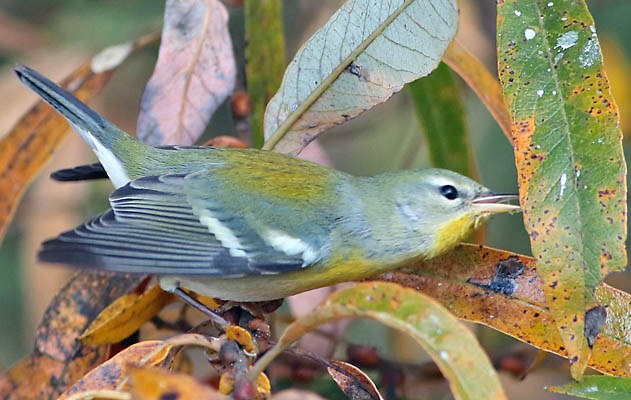 On the final day of 2017, Bruce Mast, a visiting Bay Area birder, discovered a hatch-year female Northern Parula
at Laguna Grande Park (left, photo 31 Dec © D. Roberson).
Comparison of photos of a Parula found here on 29 Nov by Don Glasco
show several plumage differences, plus the lapse in time between
sightings, suggest that this year-end Parula is a newly arrived
individual. If so it may try to winter. One at Laguna Grande from 17
Nov-6 Dec 2015 did not make it through the winter, but at least three
other Northern Parulas have wintered in MTY.
On the final day of 2017, Bruce Mast, a visiting Bay Area birder, discovered a hatch-year female Northern Parula
at Laguna Grande Park (left, photo 31 Dec © D. Roberson).
Comparison of photos of a Parula found here on 29 Nov by Don Glasco
show several plumage differences, plus the lapse in time between
sightings, suggest that this year-end Parula is a newly arrived
individual. If so it may try to winter. One at Laguna Grande from 17
Nov-6 Dec 2015 did not make it through the winter, but at least three
other Northern Parulas have wintered in MTY. 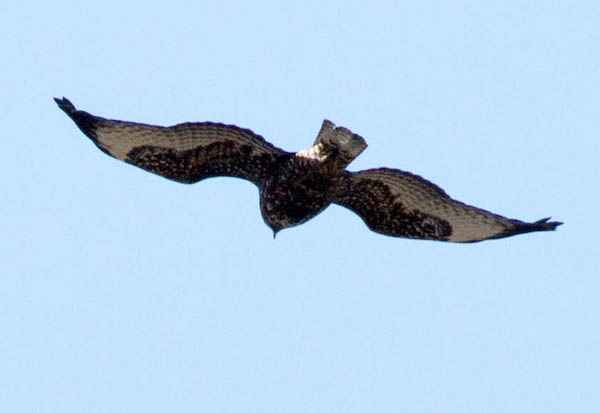
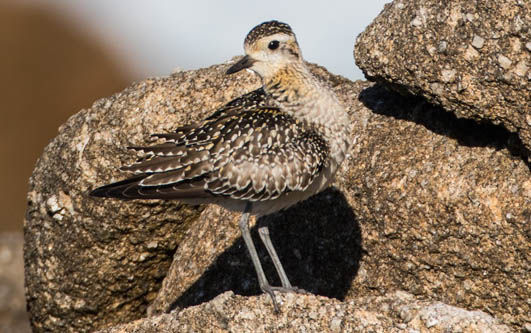
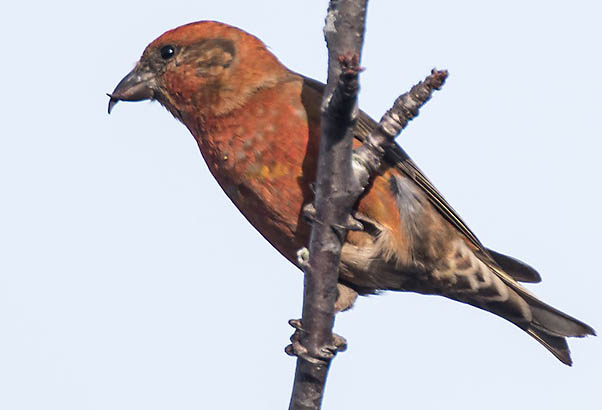
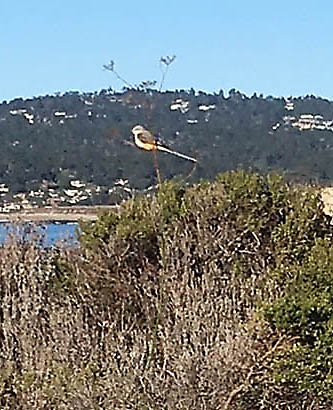
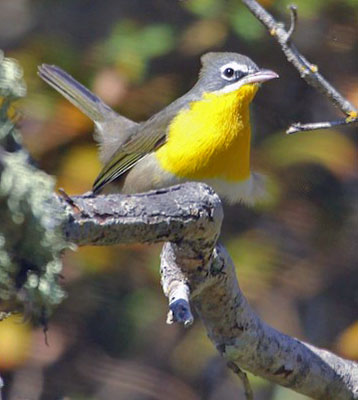
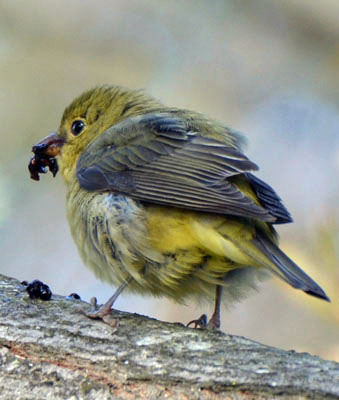
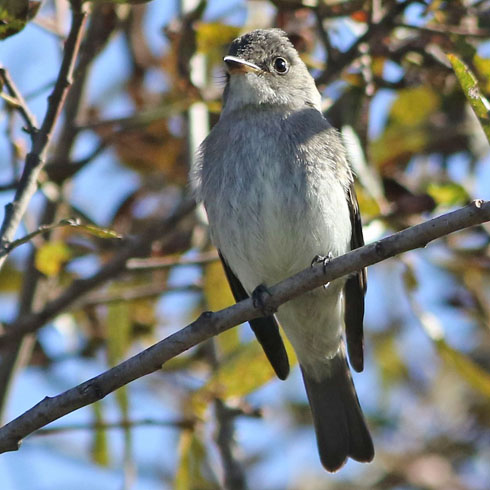

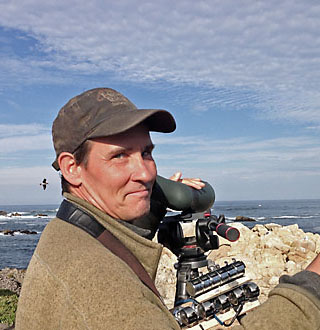



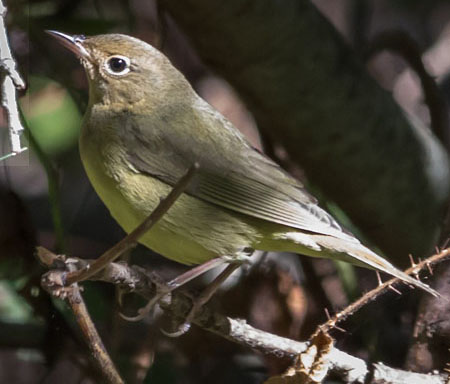
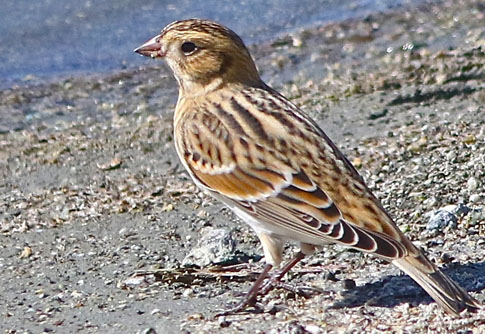
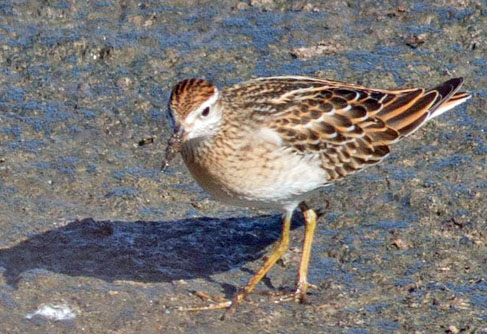
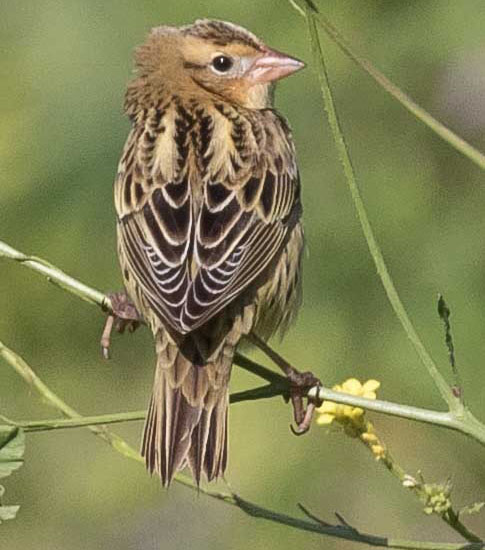
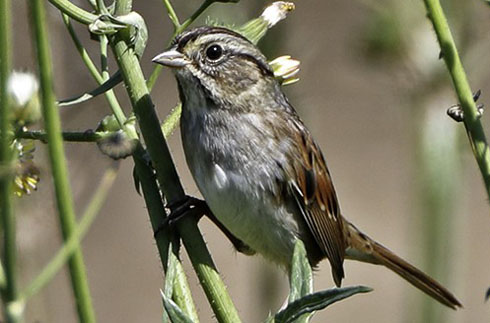
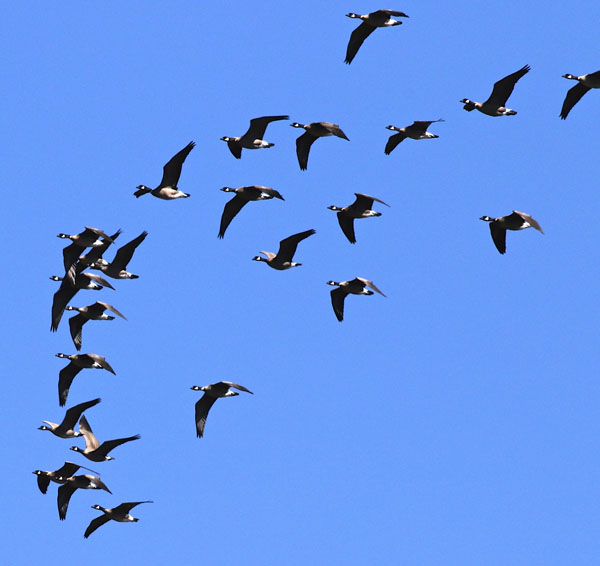 In early October, unprecedented numbers of "Aleutian" Cackling Geese
passed over the Monterey coast. On the morning of 4 Oct, for example,
Mark Kudrav watched 338 fly north over the Big Sur R. mouth [flocks of
78 and 260]. Between 9:30-11:30 a.m., Paul Fenwick, Brian Sullivan and
Cooper Scollan had 131 go over Pt. Pinos [photo below © P.
Fenwick; shows 61 geese]. Right around noon Don Roberson had 105 fly
over his Pacific Grove home and within minutes the same flock was over
Fenwick and company at the P.G. cemetery. Then between 1-5 p.m. that
day, Kent Van Vuren counted 245 in flight over Pt. Lobos (245 in one
flock, exactly 100 in the other; photo right © K. Van Vuren of 23
geese). Even assuming the mid-morning Pt. Pinos birds were part of
Kudrav's Big Sur birds, that's at least 688 Aleutian geese in MTY in a
single day. Several hundred more were located widely, in flocks of
varying size, into November. Surely more than a thousand visited MTY in
October. These numbers break the all-time abundance records of this
Aleutian subspecies leucopareia in MTY.
In early October, unprecedented numbers of "Aleutian" Cackling Geese
passed over the Monterey coast. On the morning of 4 Oct, for example,
Mark Kudrav watched 338 fly north over the Big Sur R. mouth [flocks of
78 and 260]. Between 9:30-11:30 a.m., Paul Fenwick, Brian Sullivan and
Cooper Scollan had 131 go over Pt. Pinos [photo below © P.
Fenwick; shows 61 geese]. Right around noon Don Roberson had 105 fly
over his Pacific Grove home and within minutes the same flock was over
Fenwick and company at the P.G. cemetery. Then between 1-5 p.m. that
day, Kent Van Vuren counted 245 in flight over Pt. Lobos (245 in one
flock, exactly 100 in the other; photo right © K. Van Vuren of 23
geese). Even assuming the mid-morning Pt. Pinos birds were part of
Kudrav's Big Sur birds, that's at least 688 Aleutian geese in MTY in a
single day. Several hundred more were located widely, in flocks of
varying size, into November. Surely more than a thousand visited MTY in
October. These numbers break the all-time abundance records of this
Aleutian subspecies leucopareia in MTY. 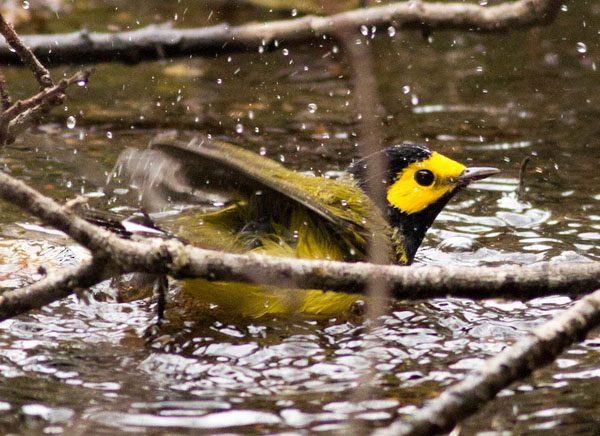 Another bathing beauty within the week was this male Hooded Warbler
splashing in the Carmel River shallows on 14 Sep (photo right ©
Paul Fenwick). Both Kentucky and Hooded Warblers are birds of
southeastern U.S., but Hoodeds sometimes appear in unexpected numbers
in spring, and MTY has over 40 records. Fall vagrants, like this one,
are decidedly scarcer.
Another bathing beauty within the week was this male Hooded Warbler
splashing in the Carmel River shallows on 14 Sep (photo right ©
Paul Fenwick). Both Kentucky and Hooded Warblers are birds of
southeastern U.S., but Hoodeds sometimes appear in unexpected numbers
in spring, and MTY has over 40 records. Fall vagrants, like this one,
are decidedly scarcer. 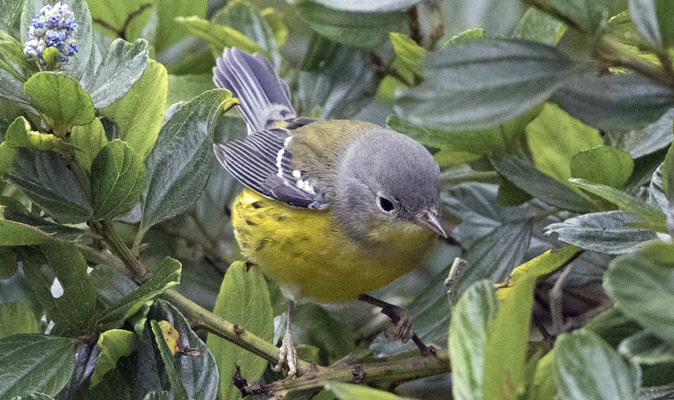 Back to warblers in early September — on 3 Sep, Rita Carratello and Larry & Carole Rose discovered an Ovenbird
walking through "the thicket" at El Carmelo cemetery in Pacific Grove
(above © Rita Carratello). This is the exact spot frequented by
another Ovenbird in fall 2014 [
Back to warblers in early September — on 3 Sep, Rita Carratello and Larry & Carole Rose discovered an Ovenbird
walking through "the thicket" at El Carmelo cemetery in Pacific Grove
(above © Rita Carratello). This is the exact spot frequented by
another Ovenbird in fall 2014 [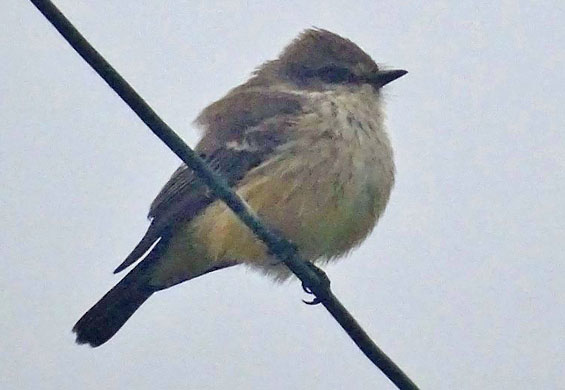 A female Vermilion Flycatcher,
found at Pt. Pinos on 14 Sep by Mark Kudrav, was another exceptional
vagrant (left © Mark Kudrav). It was the 8th MTY record but only
stayed a short time. Ironically, the most recent county record had been
a female that was present very close to the location of this year's
individual, and remained from Oct 2012 into Jan 2013. Before that, one
has to go back to 2004 [details of
A female Vermilion Flycatcher,
found at Pt. Pinos on 14 Sep by Mark Kudrav, was another exceptional
vagrant (left © Mark Kudrav). It was the 8th MTY record but only
stayed a short time. Ironically, the most recent county record had been
a female that was present very close to the location of this year's
individual, and remained from Oct 2012 into Jan 2013. Before that, one
has to go back to 2004 [details of 
